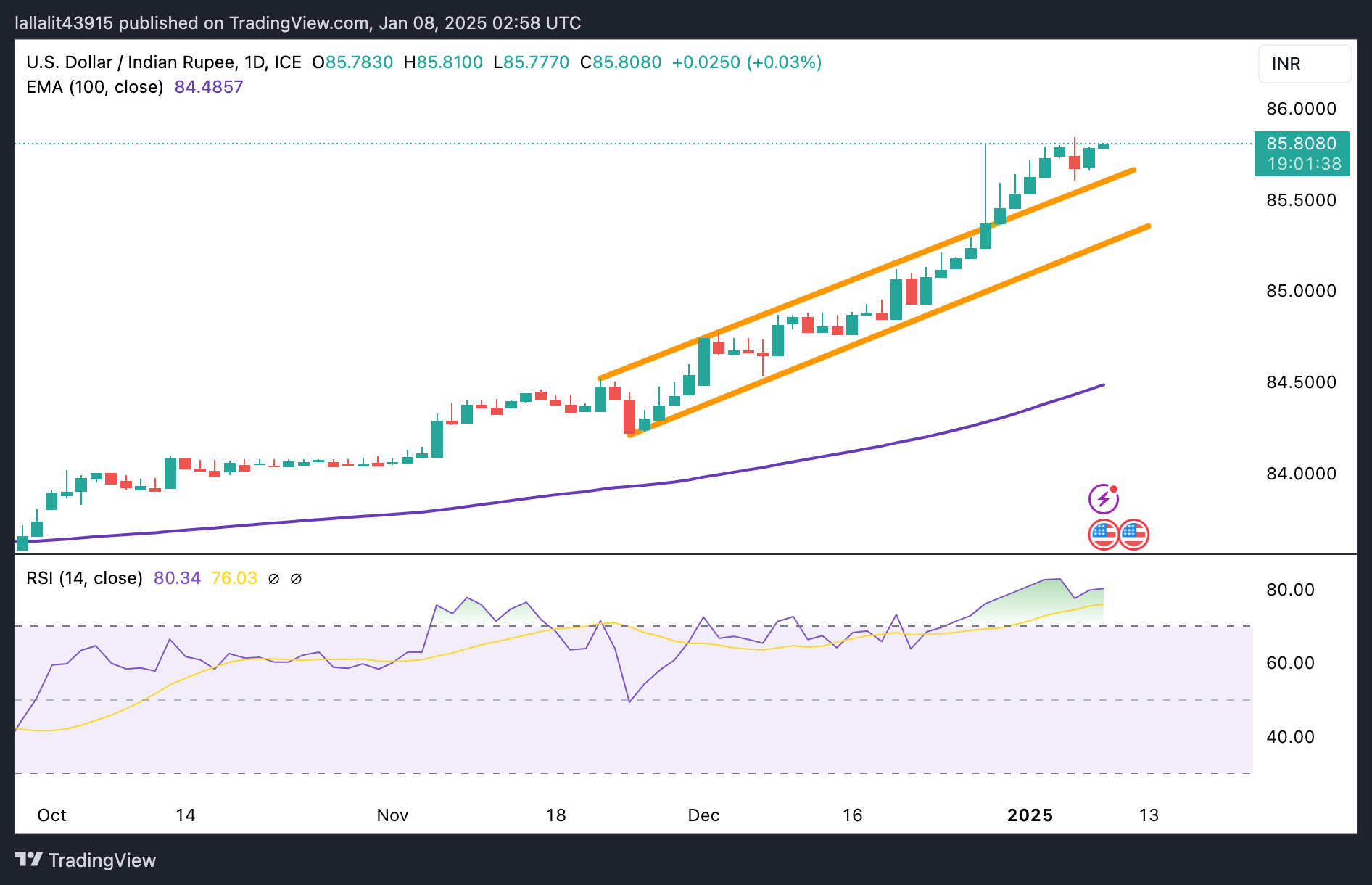USD/INR extends upside as investors await FOMC Minutes

The Indian Rupee trades softer in Wednesday’s early European session.
The USD sales help ease the INR’s pressure, but an unabated outflow of foreign capital could weigh on the INR.
Investors await the FOMC Minutes due later today.
The Indian Rupee (INR) edges lower on Wednesday after posting its biggest one-day gain in over a month in the previous session. The heavy US Dollar (USD) sales by foreign banks help ease the INR’s pressure. However, the local currency remains fragile amid the persistent outflows and higher crude oil prices. Additionally, geopolitical tensions and downside risks to India’s growth projections might drag the INR lower against the USD.
Investors will closely monitor the development surrounding the incoming US administration under Donald Trump’s tariff plan. Looking ahead, the Federal Open Market Committee (FOMC) Minutes are due later on Wednesday. The US December labor market data will be the highlight on Friday. Economists expect 154,000 new jobs for December, while the unemployment rate is expected to remain at 4.2% during the same report period. These reports will give further cues on the interest rate trajectory of the US Federal Reserve (Fed).
Indian Rupee weakens amid ongoing uncertainty on US tariffs
- India’s economy is estimated to slow significantly in FY25, with the first advance estimate revealing a real GDP growth rate of 6.4%, down from 8.2% in FY24.
- “As the dollar index fell, the Indian rupee gained up to 85.65 during the day before dollar buying from importers and oil companies pushed the rupee to 85.72/$1 levels,” said Anil Bhansali, head of treasury, Finrex Treasury Advisors.
- The RBI’s interventions in the foreign exchange market have drawn down reserves by $65 billion since their September 2024 peak to manage depreciation.
- The US Services PMI rose to 54.1 in December from 52.1 in November, according to the Institute for Supply Management (ISM) on Tuesday. This reading came in above the market consensus of 53.3.
- US JOLTS Job Openings increased to 8.09 million in November versus 7.83 million prior. The market expected 7.7 million Job Openings in November.
- Atlanta Fed President Raphael Bostic stated that the Fed officials should be cautious with policy decisions given uneven progress on lowering inflation and err on the side of keeping interest rates elevated to achieve their price stability goal, per Reuters.
- According to the CME FedWatch tool, the markets have priced in nearly a 93.5% possibility that the Fed will hold the rate steady this month.
USD/INR maintains a positive picture, but an overbought RSI warrants caution for bulls
The Indian Rupee trades firmer on the day. The constructive view of the USD/INR pair prevails, with the price holding above the key 100-day Exponential Moving Average (EMA) on the daily chart. However, further consolidation cannot be ruled out before positioning for any near-term USD/INR appreciation as the 14-day Relative Strength Index (RSI) stands near 79.60, indicating an overbought condition.
The all-time high of 85.84 acts as an immediate resistance level for USD/INR. If the pair prints bullish candlesticks and sustainably breaks above the mentioned level, it could draw in technical buyers and pave the way to the 86.00 psychological mark.
On the other hand, the first downside target to watch is 85.60, the low of January 6. Sustained trading below this level could drag the pair back down to 85.00, followed by 84.48, the 100-day EMA.
RBI FAQs
The role of the Reserve Bank of India (RBI), in its own words, is “..to maintain price stability while keeping in mind the objective of growth.” This involves maintaining the inflation rate at a stable 4% level primarily using the tool of interest rates. The RBI also maintains the exchange rate at a level that will not cause excess volatility and problems for exporters and importers, since India’s economy is heavily reliant on foreign trade, especially Oil.
The RBI formally meets at six bi-monthly meetings a year to discuss its monetary policy and, if necessary, adjust interest rates. When inflation is too high (above its 4% target), the RBI will normally raise interest rates to deter borrowing and spending, which can support the Rupee (INR). If inflation falls too far below target, the RBI might cut rates to encourage more lending, which can be negative for INR.
Due to the importance of trade to the economy, the Reserve Bank of India (RBI) actively intervenes in FX markets to maintain the exchange rate within a limited range. It does this to ensure Indian importers and exporters are not exposed to unnecessary currency risk during periods of FX volatility. The RBI buys and sells Rupees in the spot market at key levels, and uses derivatives to hedge its positions.
